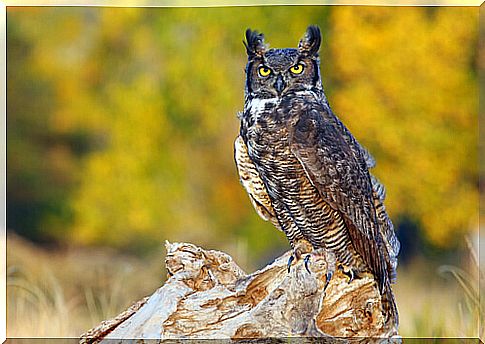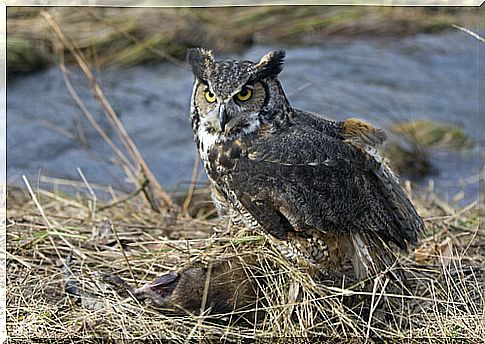The Long-eared Owl: The Largest Owl In South America

The long-eared owl, also known according to the region as the American owl, horned owl or American eagle owl is a species that belongs to the Strigiforme order of the Strigidae family . Its scientific name is Bubo virginianus and it has at least 16 subspecies.
The Bubo virginianus is the largest owl in South America. Its name Bubo derives from Latin and means owl. The epithet virginianus refers to the state of Virginia in the United States.
In the international arena it is considered a kind of minor concern. However, it is included in Appendix II of the Convention on International Trade in Endangered Species of Wild Fauna and Flora (CITES).
Characteristics of the long-eared owl
Males are about 51 centimeters tall and weigh 680 to 1450 grams. Females are about 60 centimeters tall and weigh between 1,000 and 2,500 grams.
Its body is robust, its head is rounded, its beak is short, and its tail is relatively small compared to its wide wings. It does not have protruding ears and, as a curious fact, its left outer ear is slightly lower than its right.
Although in certain regions it is called horned owl, it does not have horns. This name derives from the presence of tufts of feathers located on each side of its head that resemble horns and long ears. Females have an incubation patch on their lower body.

Brown feathers cover the entire body of the owl from the legs to the claws. This coloration allows the owl to camouflage itself among the trees. On the face it has white discs bordered with black and ear plumes. It also has a white throat and an ocher chest with a few black streaks.
Immature specimens are reddish-orange in color with a more reduced and opaque white throat patch and shorter ear tufts.
Distribution and habitat of the long-eared owl
The long-eared owl or horned owl has a wide distribution, from the Nearctic region in Alaska to the central-eastern Argentina. Therefore, it is more widely distributed in cold areas of highlands and temperate areas. In general, it tolerates altitudes from sea level up to 3 353 meters.
The long-eared owl inhabits a wide range of vegetation types, from wooded areas, mangroves, deserts, moors, secondary vegetation, scrub associated with wooded areas, plantations and savannas with isolated trees. Therefore, it is distributed in almost all climates, with the exception of the tundra and tropical rainy areas where it appears sporadically.
This species is associated with fragmented landscapes and is considered tolerant of human activities. It can be seen occasionally in parks, in cities and towns.
Eating the long-eared owl
The long-eared owl is a carnivorous bird and its effective sense of sight allows it to hunt from small insects to medium vertebrates. It is considered an opportunistic hunter, as it is not specialized in a specific prey.

The daily feeding of the owl depends on the availability of prey, but most of these are terrestrial vertebrates. Their diet generally includes: possums, mice, rats, rabbits, hares, skunks, porcupines, ducks, geese, other birds, snakes and other reptiles, frogs, toads, fish, invertebrates such as scorpions, beetles, crustaceans, and even domestic animals.
Reproduction and behavior of the long-eared owl
It can nest in old nests of other large birds, which are generally cavities in the trunk of large trees. It also nests in tall palms, on the main branch of a tree, on ledges, and sometimes on the ground.
It lays one to six eggs, which are incubated for 28 to 37 days by the female, who is fed by the male overnight. The young fly around 10-12 weeks after hatching and remain in the care of their parents for up to five more months.
Their habits are nocturnal, although they carry out activities at dusk and dawn, alone or as a couple. It rarely hunts during the day, and when it catches its prey, it does so on the ground, making steep falls from great heights. Small prey swallows them whole while large prey dismember them.
In addition, it is an extremely territorial bird. The long-eared owl hoots to defend its territory or to look for a mate. The sound that comes out of his throat sounds like a typical “hoo-hoo, hoo-hoo” and is so loud that it can be heard from several kilometers away.









